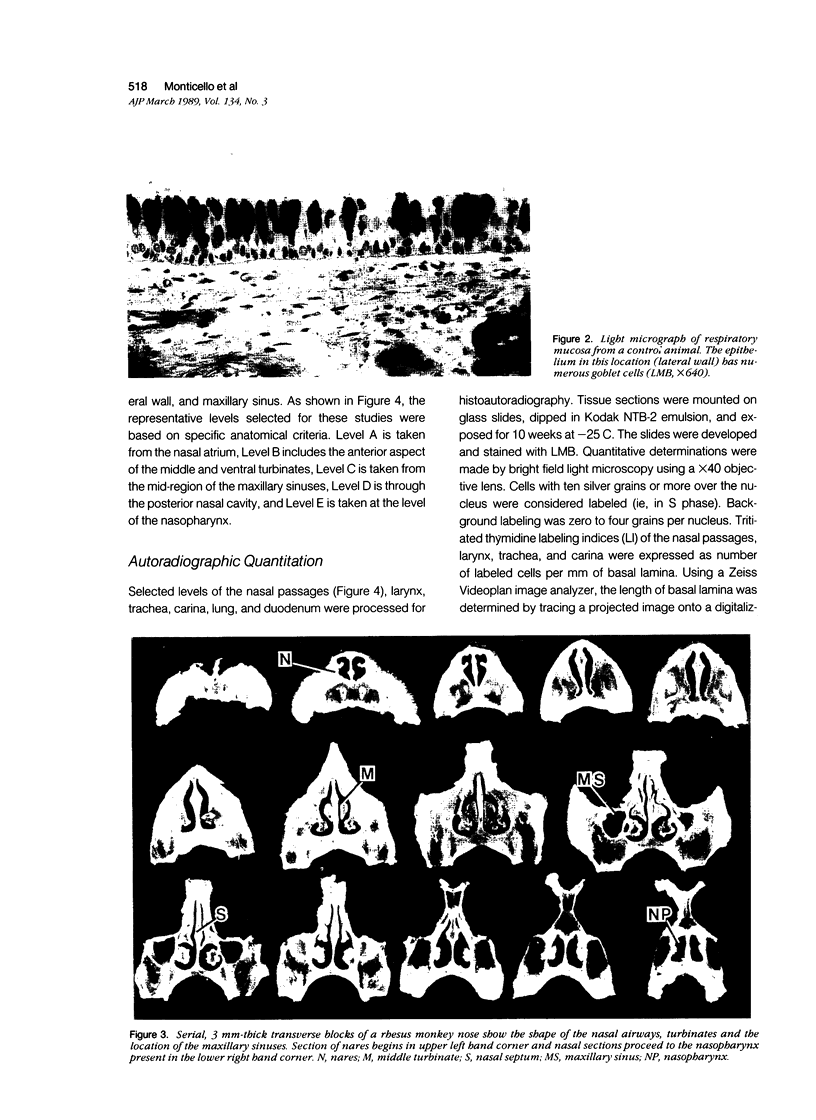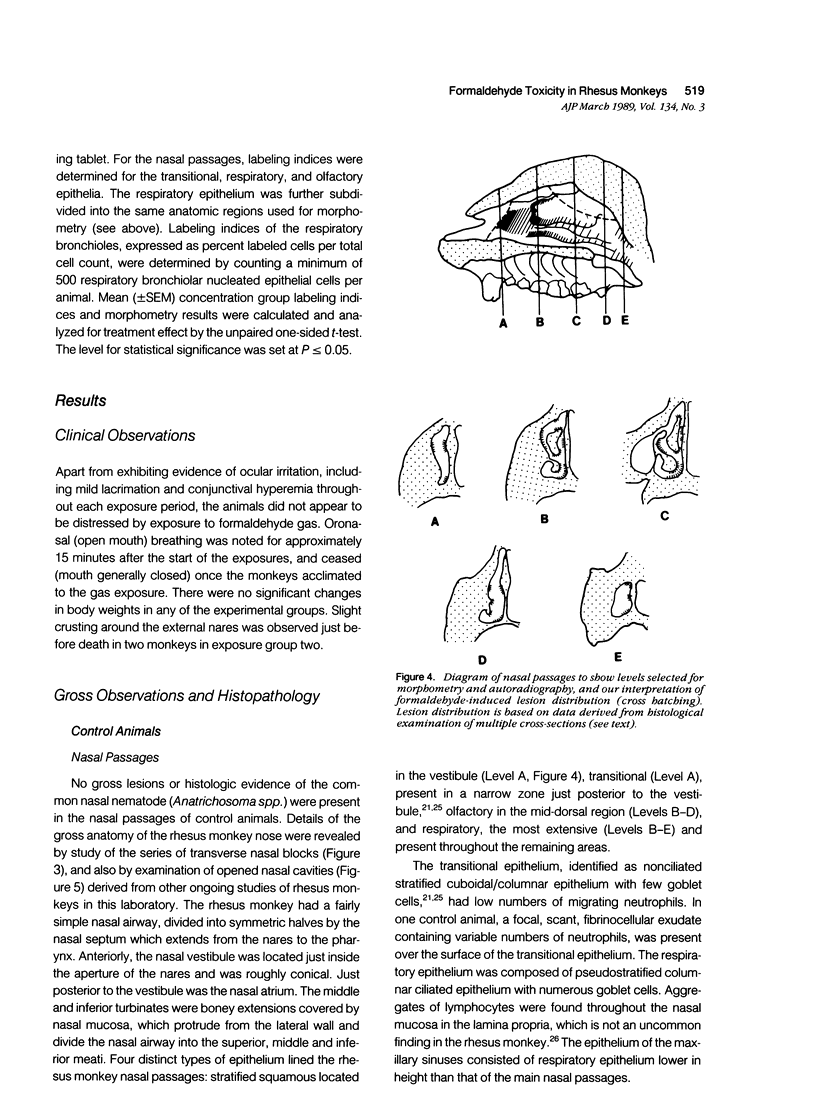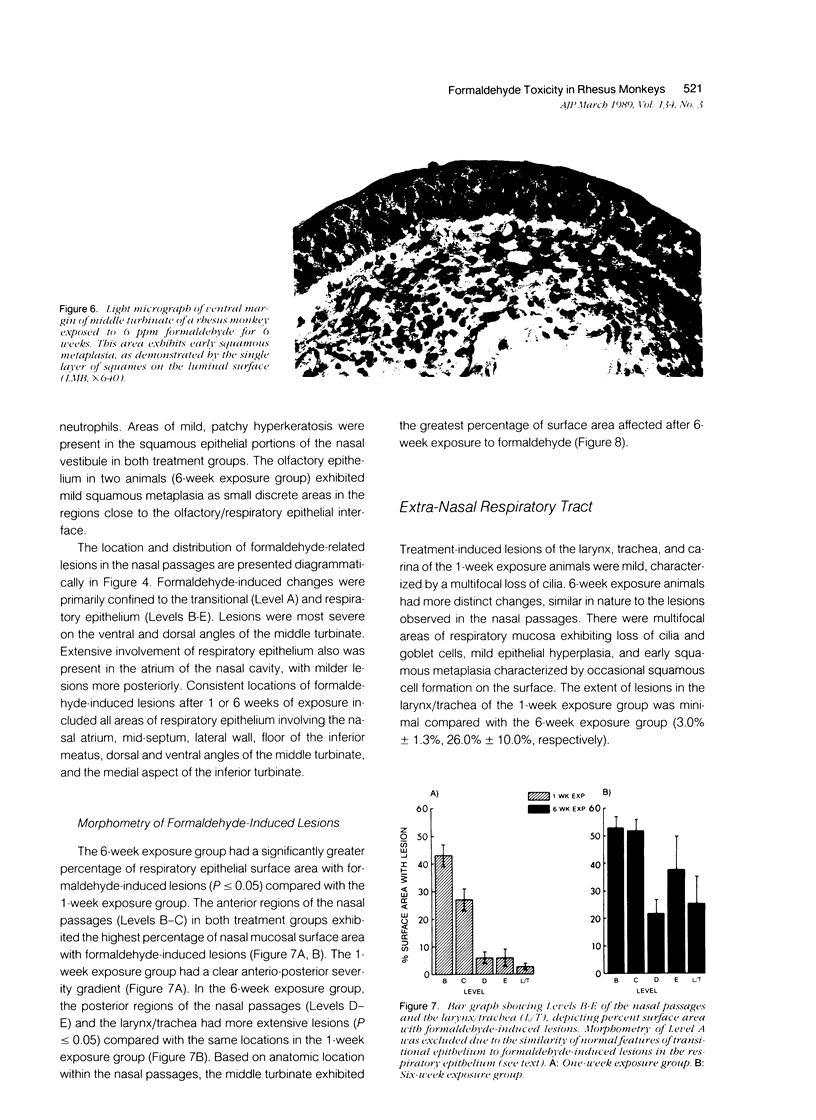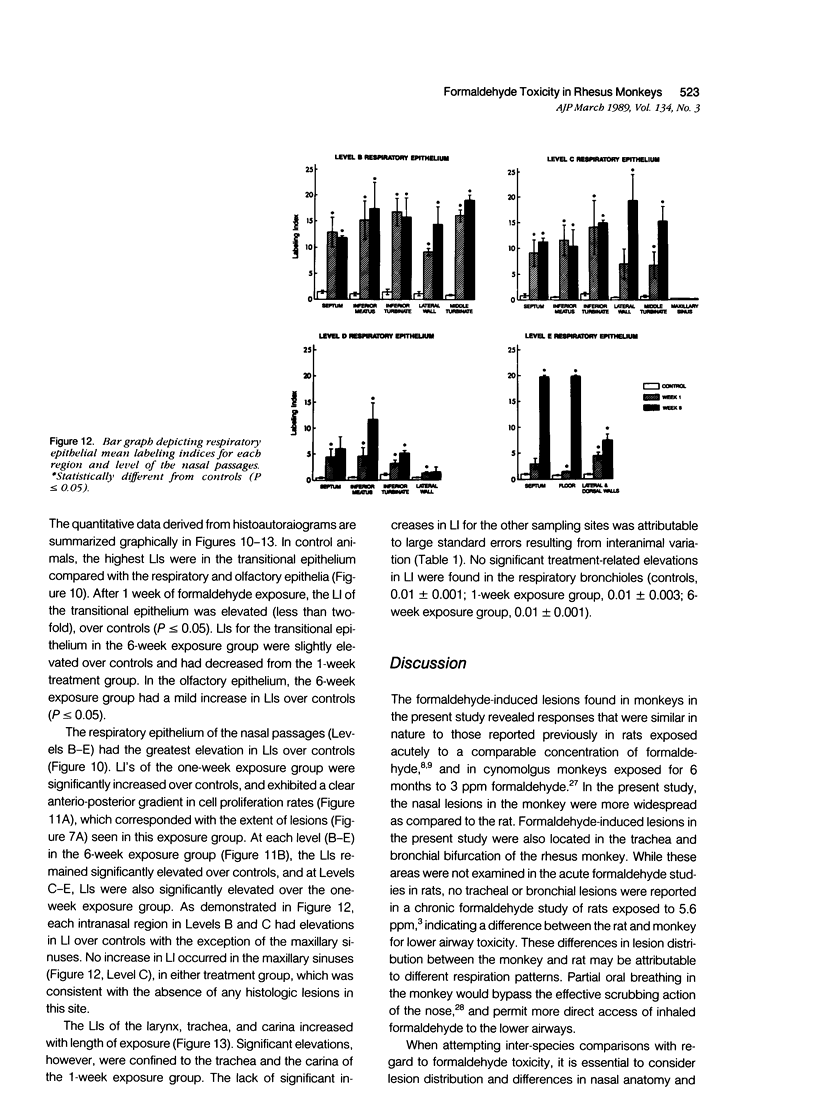Abstract
Formaldehyde is a nasal carcinogen in rats but it remains to be determined what cancer risk this chemical poses in humans. Molecular dosimetry studies of formaldehyde and cellular proliferative responses to formaldehyde-induced cytotoxicity have been studied in the rodent and are important components of the authors' ongoing research, which has now been extended to nonhuman primates, a species more analogous to humans. The present study was designed to characterize formaldehyde injury in the respiratory tract of nonhuman primates to provide a direct comparison to the toxic effects of formaldehyde in rodents. Groups of three rhesus monkeys were exposed to room air, or 6 ppm formaldehyde for 5 days per week for 1 or 6 weeks, and the respiratory tract was assessed for nature and extent of histologic responses, and changes in epithelial cell proliferation rate. Lesions were characterized by mild degeneration and early squamous metaplasia confined to specific regions of the transitional and respiratory epithelia of the nasal passages and the respiratory epithelium of the trachea and major bronchi. There was minimal progression of histologic changes between 1 and 6 weeks; however, the percent of nasal surface area affected significantly increased in the 6-week exposure group. Formaldehyde-induced lesions were associated with increases in cell proliferation rates up to 18-fold over controls, which remained significantly elevated after 6 weeks of exposure. Histologic lesions and increases in cell proliferation were most extensive in the nasal passages and were minimal in the lower airways, whereas the maxillary sinuses exhibited no evidence of a response to formaldehyde exposure. Based on the extent of lesions and cell proliferation data, it appears that the monkey is more sensitive than the rat to the acute and subacute effects of formaldehyde at 6 ppm. The absence of response in the maxillary sinuses in the monkey suggests that combining tumors of the nasal cavity and sinuses in epidemiologic studies may not be appropriate for formaldehyde cancer risk assessment. Results of this study also have provided important information for tissue sample site selection in the monkey respiratory tract for ongoing molecular dosimetry studies.
Full text
PDF












Images in this article
Selected References
These references are in PubMed. This may not be the complete list of references from this article.
- Albert R. E., Sellakumar A. R., Laskin S., Kuschner M., Nelson N., Snyder C. A. Gaseous formaldehyde and hydrogen chloride induction of nasal cancer in the rat. J Natl Cancer Inst. 1982 Apr;68(4):597–603. [PubMed] [Google Scholar]
- Blair A., Stewart P., O'Berg M., Gaffey W., Walrath J., Ward J., Bales R., Kaplan S., Cubit D. Mortality among industrial workers exposed to formaldehyde. J Natl Cancer Inst. 1986 Jun;76(6):1071–1084. [PubMed] [Google Scholar]
- Brain J. D. The uptake of inhaled gases by the nose. Ann Otol Rhinol Laryngol. 1970 Jun;79(3):529–539. doi: 10.1177/000348947007900315. [DOI] [PubMed] [Google Scholar]
- Bridger M. W., van Nostrand A. W. The nose and paranasal sinuses--applied surgical anatomy. A histologic study of whole organ sections in three planes. J Otolaryngol Suppl. 1978 Dec;6:1–33. [PubMed] [Google Scholar]
- Casanova-Schmitz M., Starr T. B., Heck H. D. Differentiation between metabolic incorporation and covalent binding in the labeling of macromolecules in the rat nasal mucosa and bone marrow by inhaled [14C]- and [3H]formaldehyde. Toxicol Appl Pharmacol. 1984 Oct;76(1):26–44. doi: 10.1016/0041-008x(84)90026-7. [DOI] [PubMed] [Google Scholar]
- Casanova M., Heck Hd'A Further studies of the metabolic incorporation and covalent binding of inhaled [3H]- and [14C]formaldehyde in Fischer-344 rats: effects of glutathione depletion. Toxicol Appl Pharmacol. 1987 Jun 15;89(1):105–121. doi: 10.1016/0041-008x(87)90181-5. [DOI] [PubMed] [Google Scholar]
- Chang J. C., Gross E. A., Swenberg J. A., Barrow C. S. Nasal cavity deposition, histopathology, and cell proliferation after single or repeated formaldehyde exposures in B6C3F1 mice and F-344 rats. Toxicol Appl Pharmacol. 1983 Apr;68(2):161–176. doi: 10.1016/0041-008x(83)90001-7. [DOI] [PubMed] [Google Scholar]
- Fabrikant J. I., Cherry J. The kinetics of cellular proliferation in normal and malignant tissues. X. Cell proliferation in the nose and adjoining cavities. Ann Otol Rhinol Laryngol. 1970 Jun;79(3):572–578. doi: 10.1177/000348947007900321. [DOI] [PubMed] [Google Scholar]
- Farber E., Sarma D. S. Hepatocarcinogenesis: a dynamic cellular perspective. Lab Invest. 1987 Jan;56(1):4–22. [PubMed] [Google Scholar]
- Ghanayem B. I., Maronpot R. R., Matthews H. B. Association of chemically induced forestomach cell proliferation and carcinogenesis. Cancer Lett. 1986 Sep;32(3):271–278. doi: 10.1016/0304-3835(86)90179-5. [DOI] [PubMed] [Google Scholar]
- Harkema J. R., Plopper C. G., Hyde D. M., St George J. A. Regional differences in quantities of histochemically detectable mucosubstances in nasal, paranasal, and nasopharyngeal epithelium of the bonnet monkey. J Histochem Cytochem. 1987 Mar;35(3):279–286. doi: 10.1177/35.3.2434556. [DOI] [PubMed] [Google Scholar]
- Harkema J. R., Plopper C. G., Hyde D. M., Wilson D. W., St George J. A., Wong V. J. Nonolfactory surface epithelium of the nasal cavity of the bonnet monkey: a morphologic and morphometric study of the transitional and respiratory epithelium. Am J Anat. 1987 Nov;180(3):266–279. doi: 10.1002/aja.1001800308. [DOI] [PubMed] [Google Scholar]
- Kerns W. D., Pavkov K. L., Donofrio D. J., Gralla E. J., Swenberg J. A. Carcinogenicity of formaldehyde in rats and mice after long-term inhalation exposure. Cancer Res. 1983 Sep;43(9):4382–4392. [PubMed] [Google Scholar]
- Klonne D. R., Ulrich C. E., Riley M. G., Hamm T. E., Jr, Morgan K. T., Barrow C. S. One-year inhalation toxicity study of chlorine in rhesus monkeys (Macaca mulatta). Fundam Appl Toxicol. 1987 Oct;9(3):557–572. doi: 10.1016/0272-0590(87)90037-6. [DOI] [PubMed] [Google Scholar]
- Loo S. K., Chin K. N. Lymphoid tissue in the nasal mucosa of primates, with particular reference to intraepithelial lymphocytes. J Anat. 1974 Apr;117(Pt 2):249–259. [PMC free article] [PubMed] [Google Scholar]
- Monteiro-Riviere N. A., Popp J. A. Ultrastructural characterization of the nasal respiratory epithelium in the rat. Am J Anat. 1984 Jan;169(1):31–43. doi: 10.1002/aja.1001690103. [DOI] [PubMed] [Google Scholar]
- Morgan K. T., Gross E. A., Patterson D. L. Distribution, progression, and recovery of acute formaldehyde-induced inhibition of nasal mucociliary function in F-344 rats. Toxicol Appl Pharmacol. 1986 Dec;86(3):448–456. doi: 10.1016/0041-008x(86)90372-8. [DOI] [PubMed] [Google Scholar]
- Morgan K. T., Jiang X. Z., Starr T. B., Kerns W. D. More precise localization of nasal tumors associated with chronic exposure of F-344 rats to formaldehyde gas. Toxicol Appl Pharmacol. 1986 Feb;82(2):264–271. doi: 10.1016/0041-008x(86)90201-2. [DOI] [PubMed] [Google Scholar]
- Morgan K. T., Patterson D. L., Gross E. A. Responses of the nasal mucociliary apparatus of F-344 rats to formaldehyde gas. Toxicol Appl Pharmacol. 1986 Jan;82(1):1–13. doi: 10.1016/0041-008x(86)90431-x. [DOI] [PubMed] [Google Scholar]
- Olsen J. H., Jensen S. P., Hink M., Faurbo K., Breum N. O., Jensen O. M. Occupational formaldehyde exposure and increased nasal cancer risk in man. Int J Cancer. 1984 Nov 15;34(5):639–644. doi: 10.1002/ijc.2910340509. [DOI] [PubMed] [Google Scholar]
- Rajewsky M. F. Tumorigenesis by exogenous carcinogens: role of target-cell proliferation and state of differentiation (development). IARC Sci Publ. 1985;(58):215–224. [PubMed] [Google Scholar]
- Rusch G. M., Clary J. J., Rinehart W. E., Bolte H. F. A 26-week inhalation toxicity study with formaldehyde in the monkey, rat, and hamster. Toxicol Appl Pharmacol. 1983 May;68(3):329–343. doi: 10.1016/0041-008x(83)90276-4. [DOI] [PubMed] [Google Scholar]
- Swenberg J. A., Barrow C. S., Boreiko C. J., Heck H. D., Levine R. J., Morgan K. T., Starr T. B. Non-linear biological responses to formaldehyde and their implications for carcinogenic risk assessment. Carcinogenesis. 1983 Aug;4(8):945–952. doi: 10.1093/carcin/4.8.945. [DOI] [PubMed] [Google Scholar]
- Swenberg J. A., Kerns W. D., Mitchell R. I., Gralla E. J., Pavkov K. L. Induction of squamous cell carcinomas of the rat nasal cavity by inhalation exposure to formaldehyde vapor. Cancer Res. 1980 Sep;40(9):3398–3402. [PubMed] [Google Scholar]
- Swenberg J. A., Richardson F. C., Boucheron J. A., Deal F. H., Belinsky S. A., Charbonneau M., Short B. G. High- to low-dose extrapolation: critical determinants involved in the dose response of carcinogenic substances. Environ Health Perspect. 1987 Dec;76:57–63. doi: 10.1289/ehp.877657. [DOI] [PMC free article] [PubMed] [Google Scholar]
- Von Hippel P. H., Wong K. Y. Dynamic aspects of native DNA structure: kinetics of the formaldehyde reaction with calf thymus DNA. J Mol Biol. 1971 Nov 14;61(3):587–613. doi: 10.1016/0022-2836(71)90066-0. [DOI] [PubMed] [Google Scholar]








